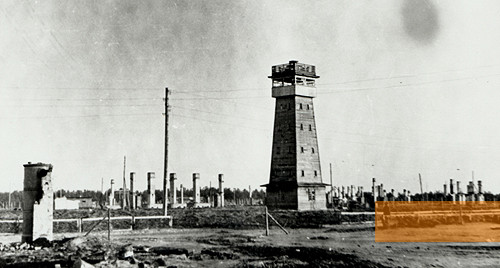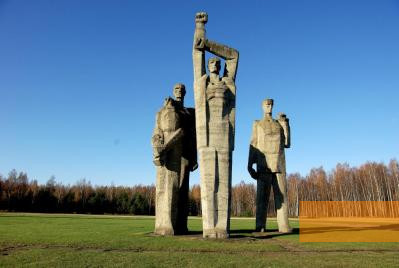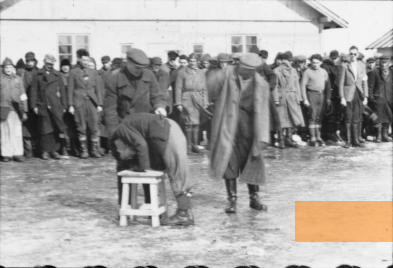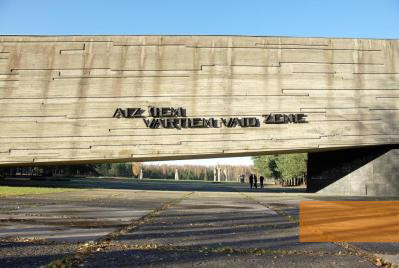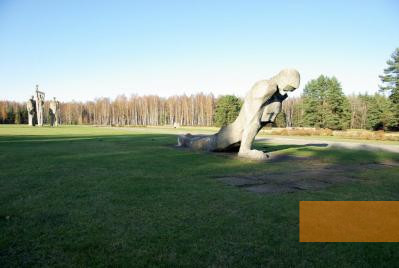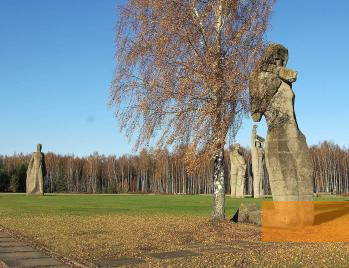Salaspils is situated around twenty kilometres from the Latvian capital Riga. The so-called »work education camp« and the »extended police prison« Salaspils were constructed in the winter of 1941/1942 under inhumane working conditions by Jewish men who had been deported from the German Reich. Salaspils was the largest camp in the Baltic region not only for civilian prisoners from Latvia, but also political prisoners of different nationalities.
In the winter of 1941/1942, the SS deployed around 1,000 Jewish men from the Jungfernhof concentration camp and from the Riga ghetto for the construction of the police prison camp Salaspils. The men were Jews who had been deported from the German Reich. They had the task of constructing barracks and watchtowers in Salaspils, as well as completing the camp's fencing. Many of the Jewish forced labourers died of the effects of the harsh working and living conditions. They had to complete strenuous tasks in the freezing cold. They were initially not provided with accommodation and hardly received any food. The SS guards were extremely brutal, punishing the Jewish forced labourers for even the smallest »offence«. Due to the high death rate among the prisoners, the SS recruited a further 500 to 800 Jews from the Riga ghetto for work until the camp's completion.
The emerging camp was under the command of the chief of the security police. From the summer of 1942, it served as a police prison camp and a work education camp for about one year for Latvians, Russians, Roma and others who were waiting for their sentence in Riga. Moreover, Salaspils served from 1943 on as a transit camp for forced labourers and around 2,300 arrested people »suspect of being partisans«, including many women and children, mostly from the region of Latgalia and from Belarus. The SS deployed many of the prisoners in forced labour in Salaspils and vicinity, amongst others in a stone quarry and a cement factory. Salaspils existed until the summer of 1944, at which point the remaining prisoners were relocated to the Stutthof concentration camp by the SS.
The emerging camp was under the command of the chief of the security police. From the summer of 1942, it served as a police prison camp and a work education camp for about one year for Latvians, Russians, Roma and others who were waiting for their sentence in Riga. Moreover, Salaspils served from 1943 on as a transit camp for forced labourers and around 2,300 arrested people »suspect of being partisans«, including many women and children, mostly from the region of Latgalia and from Belarus. The SS deployed many of the prisoners in forced labour in Salaspils and vicinity, amongst others in a stone quarry and a cement factory. Salaspils existed until the summer of 1944, at which point the remaining prisoners were relocated to the Stutthof concentration camp by the SS.
According to estimates, around 1,000 Jews from Germany perished during the construction of the Salaspils camp.
The exact number of those murdered beginning the summer of 1942 in the police prison camp is not known, estimates speak of between 2,000 and 3,000 victims.
The number of people to pass through the Salaspils camp is also not known. Newest sources state it may have been up to 12,000 prisoners.
The exact number of those murdered beginning the summer of 1942 in the police prison camp is not known, estimates speak of between 2,000 and 3,000 victims.
The number of people to pass through the Salaspils camp is also not known. Newest sources state it may have been up to 12,000 prisoners.
The memorial was erected in 1967, at a time when Latvia was part of the Soviet Union. Seven larger than life-sized sculptures stand on the former roll-call grounds of the camp, symbolising the suffering, the tenacity and success of antifascism in the fight against the National Socialist regime.
- Name
- Salaspils memoriāls
- Address
-
Rigas raj.
2121 Salaspils - Phone
- +371 (0)67216367
- Web
- https://salaspilsmemorials.lv/
- salaspils.memorials@gmail.com
- Open
- The former camp premises are accessible at all times.
Exhibition:
November to March 10 a.m. to 3 p.m.
April to October 10 a.m. to 5 p.m. - Possibilities
- Permanent exhibition, guided tours (Latvian, Russian, English)


